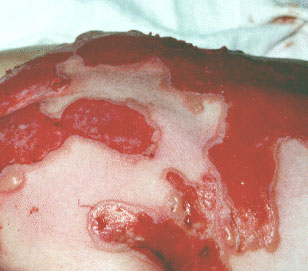|
|
|
Epidermolysis bullosa
Epidermolysis bullosa is a complex group of blistering disorders. Diseases within this group can generally be differentiated clinically, and electron microscopically.
Epidermolysis bullosa lesions show tense bullae. Blisters resolve with scarring in some variants, and milia in scars are common.
Variants:
- EB simplex of the hands and feet (Weber-Cockayne syndrome) variant is autosomal dominant. It is generally a relatively mild condition with blistering occurring secondary to significant trauma to the hands and feet.
- EB simplex (Dowling-Meara) shows herpetiform multiple small bullae and vesicles that can be extensive involving mucous membranes, as well as the skin surface of infants.
This condition commonly improves with age.
- Lethal junctional EB (Herlitz syndrome) shows blistering and erosions present at or soon after birth, becoming generalized. The extensive involvement of the mouth and larynx, as well as GI tract, results in severe refractory anemia. Many infants die early in infancy with infection.
- Recessive generalized dystrophic EB (Hallopeau) is similar to the lethal variant but death in adolescence rather than infancy is more common. Extensive scarring develops, with fusion of the fingers. Chronic ulcerations with squamous carcinoma can develop. GI tract involvement can result in a chronic anemia that can be very severe.
- Acquired epidermolysis bullosa has subepidermal blistering, showing IgG deposition along the dermal epidermal junction. Clinically these patients closely resemble the mild variant of dominant dystrophic EB, but lack the family history.
- In addition there are many other less common subtypes of EB
Treatment:
At the present time there is no good therapy. Lesions in epidermolysis bullosa of all variants occur secondary to trauma, little or great.
Avoidance of trauma is essential.
- The severe recessive forms require aggressive nursing management.
- The underlying anemia in these patients should be treated.
- Watch for the development of squamous carcinoma in dystrophic forms.

Back to Dermatology Glossary - E Index |
Back to Dermatology Glossary Index
|